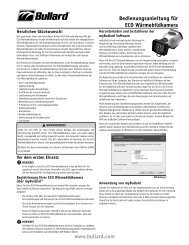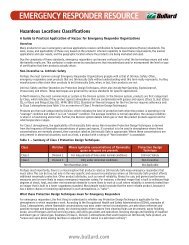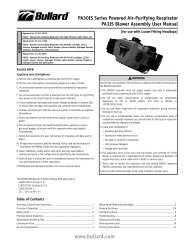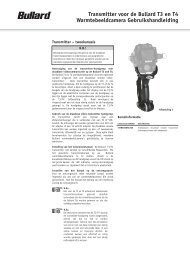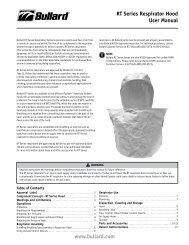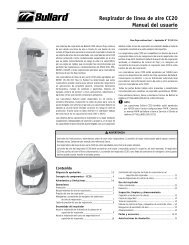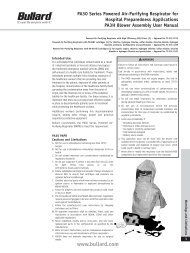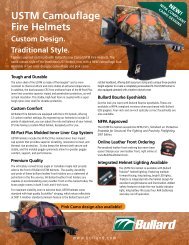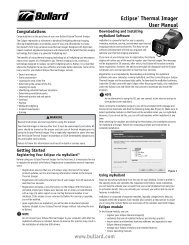88E Series Airline Respirator User Manual - Bullard
88E Series Airline Respirator User Manual - Bullard
88E Series Airline Respirator User Manual - Bullard
You also want an ePaper? Increase the reach of your titles
YUMPU automatically turns print PDFs into web optimized ePapers that Google loves.
GENERAL INFORMATION<br />
<strong>Bullard</strong>’s <strong>88E</strong> <strong>Series</strong> airline respirators, when properly used, provide a continuous flow of air<br />
from a remote air source to the respirator wearer. <strong>88E</strong> <strong>Series</strong> respirators offer protection from<br />
airborne contaminants that are not immediately dangerous to life or health or that do not exceed<br />
concentrations allowed by applicable regulations and recommendations. If you have any questions<br />
concerning the use of this respirator, or if you are not sure whether the atmosphere you<br />
are working in is immediately dangerous to your life or health, ask your employer. All instructions<br />
for the use and care of this product should be supplied to you by your employer as recommended<br />
by the manufacturer.<br />
<strong>88E</strong> <strong>Series</strong> airline respirators are approved to provide respiratory protection in general purpose<br />
applications including heavy and light-duty abrasive blasting. The cape is designed to protect the<br />
worker’s body from abrasive rebound.<br />
This respirator, when properly fitted and used, significantly reduces, but does not completely<br />
eliminate, the breathing of contaminants by the respirator wearer. When properly fitted, used<br />
and maintained, it will provide protection up to 1000x occupational exposure limit. (Check regulatory<br />
requirements to determine exposure limits.)<br />
Improper respirator use may damage your health and/or cause your death. Improper use may<br />
also cause certain life-threatening delayed lung diseases such as silicosis or pneumoconiosis.<br />
This respirator is not suitable for use in flammable atmospheres and is not designed for use in<br />
exceptionally low or high temperatures where moisture in the air could freeze or the worker<br />
could be at risk for heat exhaustion. The air supply moisture content should be controlled to avoid<br />
freezing the apparatus when used at temperatures below 4° C.<br />
FACE AND EYES<br />
The respirator’s inner lens provides protection to EN 166 (low energy impact). Wear appropriate<br />
safety glasses or goggles if higher protection levels are required.<br />
HEAD<br />
This respirator is designed to provide limited head protection by reducing the force of falling<br />
objects striking the top of the helmet.<br />
Breathing Air Pressure Table<br />
This table defines the air pressure ranges necessary to provide <strong>88E</strong> <strong>Series</strong> respirators with a volume of air that falls within the required range.<br />
The respirator provides an air flow of 210-345 lpm to the user. The minimum length of air supply hose is 10 meters, and the maximum length is<br />
20 meters.<br />
1 2 3 4<br />
AIR SOURCE FLOW CONTROL DEVICE HOSE LENGTH POINT OF ATTACHMENT PRESSURE<br />
COMPONENT CONCEPT<br />
<strong>Bullard</strong>’s <strong>88E</strong> <strong>Series</strong> airline respirators consist of three<br />
components (Figure 1): respirator helmet assembly, breathing<br />
tube assembly and air supply hose. All components must be<br />
present and properly assembled to constitute a complete CE<br />
approved respirator.<br />
1. RESPIRATOR HELMET ASSEMBLY: Includes inner shell,<br />
headband suspension, chin strap and cape.<br />
<strong>Respirator</strong> Helmet* Cape<br />
<strong>88E</strong> 4644E<br />
* NOTE: Optional accessories: 88VXLC Lens Cover.<br />
2. BREATHING TUBE ASSEMBLY: Connects respirator<br />
helmet to air supply hose by an adjustable airflow control<br />
device (F100E) and belt.<br />
3. AIR SUPPLY HOSE: Connects breathing tube to air source<br />
supplying clean breathable air.<br />
1<br />
Stationary or portable<br />
F100E<br />
F100E<br />
WARNING<br />
Do not modify or alter this respirator in any manner. Failure<br />
to use complete CE approved <strong>Bullard</strong> components and<br />
replacement parts voids approval of entire assembly.<br />
Hose for High Pressure Compressed Air Source<br />
E10<br />
3/8” I.D. Hose<br />
E1010<br />
E1020<br />
Available in 10 and 20 meter lengths.<br />
10 meter<br />
20 meter<br />
➀<br />
<strong>Respirator</strong> Helmet with Cape Attached<br />
➁<br />
Breathing Tube Assembly<br />
➂<br />
Air Supply Hose<br />
Clean, Breathable Air Source<br />
Low Flow Indicator<br />
The low flow indicator is located on the F100E flow control device. The indicator must be checked<br />
periodically when the respirator is in use. During use, the needle on the low flow indicator should<br />
point into the green section of the gauge indicating proper flow levels. If the needle dips into the<br />
red section, leave the work area immediately as you are receiving less than the required air flow<br />
for safe operation.<br />
WARNING<br />
The Low Flow indicator must be checked periodically while the respirator is in use.<br />
Breathing Air Pressure<br />
Air pressure must be continually monitored at the point-of-attachment while operating this<br />
respirator. A reliable air pressure gauge must be present to permit you to continually monitor<br />
the pressure during actual respirator operation.<br />
WARNING<br />
Failure to supply the minimum required pressure at the point-of-attachment for your<br />
hose length and type will reduce airflow and may expose you to life-threatening<br />
conditions, diseases or death.<br />
Breathing Air Pressure<br />
CE approved <strong>Bullard</strong> air supply hose(s) MUST be used between the breathing tube connection<br />
fitting on the wearer’s belt and the point-of-attachment to the air supply (Figure 3).<br />
When connecting lengths of E10 hose together, only use <strong>Bullard</strong> V11 hose-to-hose adaptors.<br />
Secure connection(s) until wrench-tight and leak-free. Total connected hose length and number<br />
of hoses MUST be within the ranges specified on the Breathing Air Pressure Table.<br />
The breathing tube connection fitting MUST be secured to the belt that is supplied with this respirator.<br />
Securing the air entry connection fitting helps prevent the air supply hose from snagging,<br />
disconnecting or pulling the respirator helmet off your head.<br />
Before you can size the headband suspension, the cape and headband must be removed from<br />
the helmet using the following steps:<br />
Bar (PSIG)<br />
4.8-5.0 (69-72)<br />
5.0-5.2 (72-75)<br />
➤<br />
Inner and Outer Window<br />
Lenses<br />
OPERATIONS<br />
WARNING<br />
At very high work rates, the pressure in the hood<br />
may become negative at peak inhalation flow. To<br />
minimize this potential, utilize the maximum air pressure<br />
specified in the Breathing Air Pressure Table<br />
and adjust flow control valve to maximum flow.<br />
Suspension<br />
Chin Strap<br />
Air Flow<br />
Control Device<br />
Inner Shell<br />
Cape<br />
Belt<br />
Figure 1



